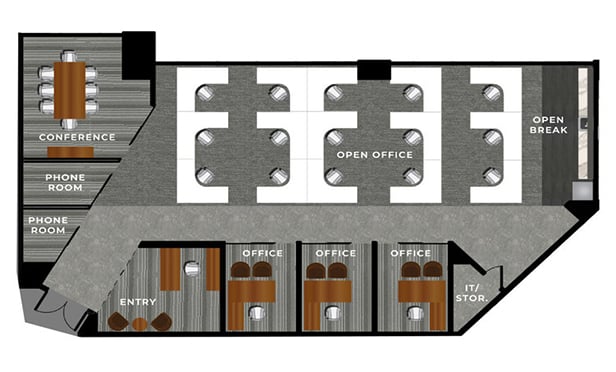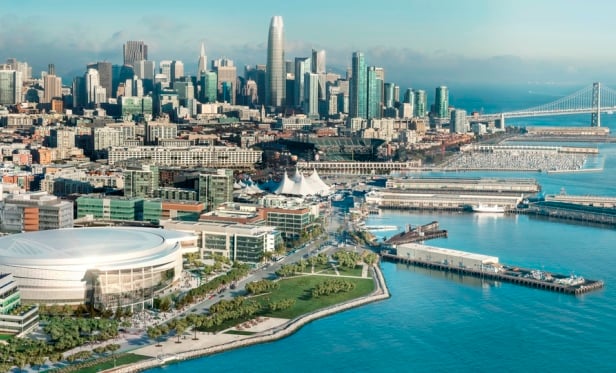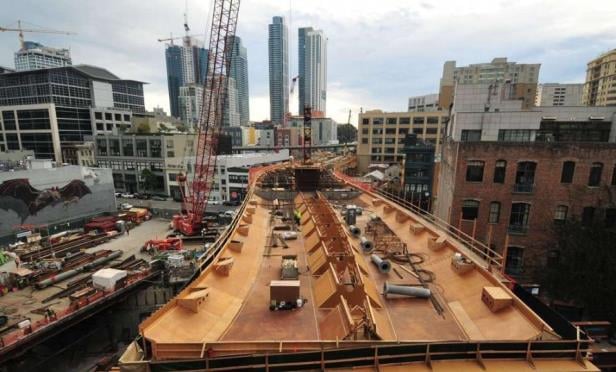
HOUSTON—It's been five weeks since Hurricane Harvey. Progress is being made, as evident from the stats from local research companies which provide an update and recap of the damage to commercial real estate properties in the area.
ApartmentData.com has been conducting one-on-one interviews with managers at 2,725 apartment properties in Greater Houston to obtain an accurate assessment of the number of units damaged by Harvey. As of September 22, the multifamily research company surveyed 2,610 or 95.8% of those 2,725 properties, GlobeSt.com learns.
The survey findings indicate that 210 properties reported damage to 14,852 units, about 2.4% of the supply of surveyed properties and 2.3% of the total supply of apartments. The overall average effective rent per month rose by $16 to $1,000 from $984 pre-Harvey.
The overall occupancy rate has dropped to 88.3% from 89.1% pre-Harvey. This rate is based on keeping the damaged units in supply, resulting in 74,738 units available to rent. If the damaged units are not included in supply, then the occupancy rate is 90.4% and there are 61,311 units available to rent. Since September 1, 2017, 8,123 units have been leased. Prior to Harvey, the inventory of 2,725 properties represented 638,603 units and 70,000 units were available to rent.
Nearly all of Houston's office buildings escaped the worst flooding. CBRE research estimates that of the city's 1,200-building 214 million-square-foot total inventory, fewer than 40 buildings totaling approximately 9 million square feet had some level of damage. Most of the office product impacted by flooding is in four areas to the west and northwest of the CBD: West Houston, Allen Parkway, West Loop/Galleria and FM 1960/Highway 249. These submarkets comprise 35% of the total Houston office market, which were 84% occupied at the end of the second quarter.
CBRE says the majority of Houston's industrial product weathered the storm with no major structural damage. There were isolated instances of damage to institutional dock-high class-A product, particularly on the West Side and along the I-10 corridor. Houston's largest industrial cluster, the inner Northwest and inner North/Northeast, reported few major damaged or destroyed properties, according to FEMA.
Moody's Analytics estimates a loss of 6% to 8% of industrial value or $2.6 billion, based on analysis and comparison to similar occurrences. The damage likely is greater within older properties and those located near Houston's bayous.
Several national building supply companies have secured additional space for the extensive $100 billion-plus rebuilding effort that will occur during the next year. A resulting spike in requirements ranging from 20,000 to 500,000 square feet is expected to put downward pressure on industrial vacancy rates for the near term, says CBRE. Many non-flood-related industrial requirements will likely now go unfulfilled.
Houston's massive reconstruction and repair project (including an estimated 100,000 homes) likely will fuel a significant increase in industrial occupancy, particularly in light-industrial space, which correlates with building and construction material distribution.
Houston's land market is dominated by retail, industrial and single-family development, as the office and multifamily sectors were over-supplied prior to Harvey. Northwest Houston will remain the desired industrial land choice and vacant commercial sites in the Port Houston area will be even harder to find. Retailers acquiring land sites could change the footprint for completed retail product as smaller warehouses with retail storefront space replace traditional big-box and junior-box retail spaces.
Although initial reports were of relatively few closures among Houston's 868 hotels totaling 85,615 rooms, some properties that remained open suffered flooding and/or reduced services. Looking at hotel data from comparable disasters, demand rose by 10% to 40% in the surrounding markets in the month after each event. Demand was still up an average of 15% four months after each event because of displaced residents, FEMA staff, emergency personnel and construction workers. Growth rates by market will vary from Harvey's impact, with Houston likely to have the largest increases in demand. Nearby cities such as Austin, San Antonio and DFW may also get demand from meetings and conventions originally booked for Houston, says CBRE.
Assuming that Harvey has a similar impact as past major storms, that there is no significant increase in room rates and that there is no major decline in the number of available hotel rooms, then hotels in the five major Texas markets could generate an additional 3.4 million room nights of demand and roughly $430 million in additional revenue. Given CBRE's current US forecast of a 3.5% increase in RevPAR for fourth quarter 2017, this additional demand would increase the RevPAR growth rate to 4.4% for the quarter and raise the overall RevPAR outlook for the year to 3.1% from the current forecast of 2.8%.
Prior to Harvey, Houston's class-A retail market was 97% occupied in the second quarter, which as a record high. Hurricane damage to retail properties was not widespread; it was mainly limited to neighborhood and strip centers in the hardest hit areas, such as the suburban and mainly single-family residential neighborhood of Kingwood to the northeast, Cypress in the northwest and to West Houston.
As a result, Harvey is not expected to impact national retailers' expansion plans, although a market strained by limited availability will continue to hinder leasing. Displaced retail tenants have already begun searching for temporary space, with little success due to the tight market conditions. Home improvement and related retailers already active in the robust housing market are expediting location decisions to capture demand for housing repairs due to the historic flooding, according to CBRE.
Local retail sales will increase, especially for durable goods such as automotive, home improvement, furniture and appliances, as Houstonians begin to rebuild homes. Retail sales tax receipts will spike mainly in Harris, Montgomery and Fort Bend counties.

HOUSTON—It's been five weeks since Hurricane Harvey. Progress is being made, as evident from the stats from local research companies which provide an update and recap of the damage to commercial real estate properties in the area.
ApartmentData.com has been conducting one-on-one interviews with managers at 2,725 apartment properties in Greater Houston to obtain an accurate assessment of the number of units damaged by Harvey. As of September 22, the multifamily research company surveyed 2,610 or 95.8% of those 2,725 properties, GlobeSt.com learns.
The survey findings indicate that 210 properties reported damage to 14,852 units, about 2.4% of the supply of surveyed properties and 2.3% of the total supply of apartments. The overall average effective rent per month rose by $16 to $1,000 from $984 pre-Harvey.
The overall occupancy rate has dropped to 88.3% from 89.1% pre-Harvey. This rate is based on keeping the damaged units in supply, resulting in 74,738 units available to rent. If the damaged units are not included in supply, then the occupancy rate is 90.4% and there are 61,311 units available to rent. Since September 1, 2017, 8,123 units have been leased. Prior to Harvey, the inventory of 2,725 properties represented 638,603 units and 70,000 units were available to rent.
Nearly all of Houston's office buildings escaped the worst flooding. CBRE research estimates that of the city's 1,200-building 214 million-square-foot total inventory, fewer than 40 buildings totaling approximately 9 million square feet had some level of damage. Most of the office product impacted by flooding is in four areas to the west and northwest of the CBD: West Houston, Allen Parkway, West Loop/Galleria and FM 1960/Highway 249. These submarkets comprise 35% of the total Houston office market, which were 84% occupied at the end of the second quarter.
CBRE says the majority of Houston's industrial product weathered the storm with no major structural damage. There were isolated instances of damage to institutional dock-high class-A product, particularly on the West Side and along the I-10 corridor. Houston's largest industrial cluster, the inner Northwest and inner North/Northeast, reported few major damaged or destroyed properties, according to FEMA.
Moody's Analytics estimates a loss of 6% to 8% of industrial value or $2.6 billion, based on analysis and comparison to similar occurrences. The damage likely is greater within older properties and those located near Houston's bayous.
Several national building supply companies have secured additional space for the extensive $100 billion-plus rebuilding effort that will occur during the next year. A resulting spike in requirements ranging from 20,000 to 500,000 square feet is expected to put downward pressure on industrial vacancy rates for the near term, says CBRE. Many non-flood-related industrial requirements will likely now go unfulfilled.
Houston's massive reconstruction and repair project (including an estimated 100,000 homes) likely will fuel a significant increase in industrial occupancy, particularly in light-industrial space, which correlates with building and construction material distribution.
Houston's land market is dominated by retail, industrial and single-family development, as the office and multifamily sectors were over-supplied prior to Harvey. Northwest Houston will remain the desired industrial land choice and vacant commercial sites in the Port Houston area will be even harder to find. Retailers acquiring land sites could change the footprint for completed retail product as smaller warehouses with retail storefront space replace traditional big-box and junior-box retail spaces.
Although initial reports were of relatively few closures among Houston's 868 hotels totaling 85,615 rooms, some properties that remained open suffered flooding and/or reduced services. Looking at hotel data from comparable disasters, demand rose by 10% to 40% in the surrounding markets in the month after each event. Demand was still up an average of 15% four months after each event because of displaced residents, FEMA staff, emergency personnel and construction workers. Growth rates by market will vary from Harvey's impact, with Houston likely to have the largest increases in demand. Nearby cities such as Austin, San Antonio and DFW may also get demand from meetings and conventions originally booked for Houston, says CBRE.
Assuming that Harvey has a similar impact as past major storms, that there is no significant increase in room rates and that there is no major decline in the number of available hotel rooms, then hotels in the five major Texas markets could generate an additional 3.4 million room nights of demand and roughly $430 million in additional revenue. Given CBRE's current US forecast of a 3.5% increase in RevPAR for fourth quarter 2017, this additional demand would increase the RevPAR growth rate to 4.4% for the quarter and raise the overall RevPAR outlook for the year to 3.1% from the current forecast of 2.8%.
Prior to Harvey, Houston's class-A retail market was 97% occupied in the second quarter, which as a record high. Hurricane damage to retail properties was not widespread; it was mainly limited to neighborhood and strip centers in the hardest hit areas, such as the suburban and mainly single-family residential neighborhood of Kingwood to the northeast, Cypress in the northwest and to West Houston.
As a result, Harvey is not expected to impact national retailers' expansion plans, although a market strained by limited availability will continue to hinder leasing. Displaced retail tenants have already begun searching for temporary space, with little success due to the tight market conditions. Home improvement and related retailers already active in the robust housing market are expediting location decisions to capture demand for housing repairs due to the historic flooding, according to CBRE.
Local retail sales will increase, especially for durable goods such as automotive, home improvement, furniture and appliances, as Houstonians begin to rebuild homes. Retail sales tax receipts will spike mainly in Harris, Montgomery and Fort Bend counties.
© 2025 ALM Global, LLC, All Rights Reserved. Request academic re-use from www.copyright.com. All other uses, submit a request to [email protected]. For more information visit Asset & Logo Licensing.









